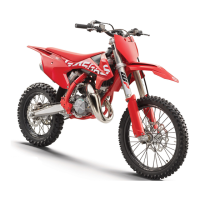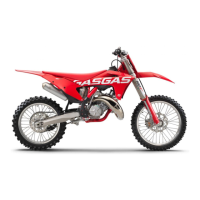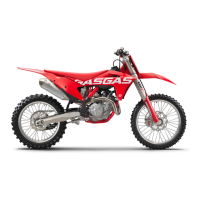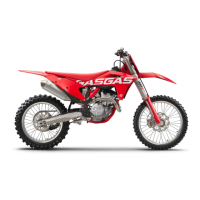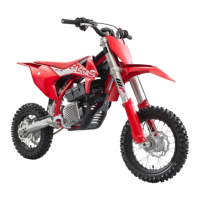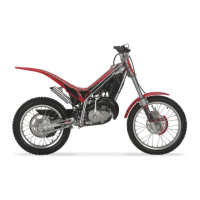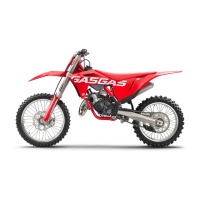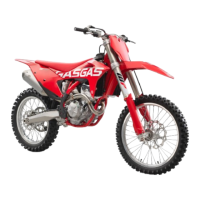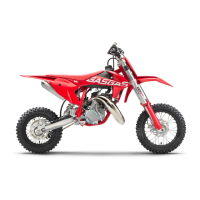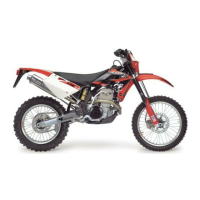Do you have a question about the GAS GAS MC 85 2021 and is the answer not in the manual?
Explains the meaning of symbols used in the manual.
Explains typographical formats used in the manual.
Defines the intended use of the vehicle and compliance with regulations.
Describes dangers and consequences of using the vehicle not as intended.
Identifies danger levels and associated warning symbols.
Covers safe operating practices, rider fitness, and maintenance.
Emphasizes the importance of appropriate protective clothing for the rider.
Details warranty conditions and voiding clauses.
Notes environmental hazards of fuel and proper usage.
Highlights the importance of regular service for operation and wear prevention.
Illustrates and labels key components on the front left of the vehicle.
Illustrates and labels key components on the rear right of the vehicle.
Shows the location of the VIN on the vehicle.
Shows where the engine number is stamped on the engine.
Indicates where the shock absorber article number is stamped.
Describes the clutch lever and its operation.
Describes the front brake lever and its function.
Explains the throttle grip and engine kill switch functions.
Provides safety warnings and instructions for opening and closing the fuel tank cap.
Describes the fuel tap, choke, and their functions.
Describes the rear brake lever and kick starter operation.
Provides essential safety and preparation advice for new riders.
Details the engine break-in procedure and performance guidelines.
Advises on preparing the vehicle for challenging terrain and conditions.
Adjustments for operating in hot weather or slow riding conditions.
Lists essential pre-ride checks to ensure safe operation.
Instructions and safety warnings for starting the engine.
Explains proper braking techniques and potential issues.
Safety warnings and procedures for refueling the vehicle.
Details mandatory maintenance tasks at various intervals.
Lists recommended maintenance tasks for optimal performance and longevity.
How to adjust the air pressure in the front fork.
How to check the static and riding sag of the rear shock absorber.
Procedure for adjusting the shock absorber's spring preload and riding sag.
Procedure for safely lifting and securing the motorcycle using a stand.
Detailed steps for adjusting the drive chain tension correctly.
Procedure to check and change the hydraulic clutch fluid level.
How to check the front brake fluid level and identify potential issues.
Detailed procedure for replacing front brake linings.
How to check the rear brake fluid level and identify potential issues.
How to check the minimum thickness and condition of rear brake linings.
Step-by-step guide to remove and install the front wheel.
Procedure to remove and install the rear wheel.
Procedure for checking tire pressure and spoke tension.
How to check coolant concentration and level.
Instructions for refilling the cooling system with coolant.
Explains how carburetor components affect engine performance.
Details on setting the carburetor for optimal idle speed.
How to check the shift lever position relative to the rider's boot.
How to check the engine's gear oil level.
Procedure for draining and refilling the gear oil.
Guidelines and precautions for cleaning the motorcycle.
Steps and precautions for storing the motorcycle for extended periods.
Procedures for getting the motorcycle ready after it has been stored.
Technical specifications related to the engine.
Torque specifications for various engine fasteners.
Detailed chart for carburetor tuning based on altitude and temperature.
Torque specifications for various chassis fasteners.
Details on brake fluid standards, guidelines, and suppliers.
Guidelines for coolant type, antifreeze protection, and suppliers.
Information on engine oil standards, guidelines, and recommended suppliers.
Explains the meaning of symbols used in the manual.
Explains typographical formats used in the manual.
Defines the intended use of the vehicle and compliance with regulations.
Describes dangers and consequences of using the vehicle not as intended.
Identifies danger levels and associated warning symbols.
Covers safe operating practices, rider fitness, and maintenance.
Emphasizes the importance of appropriate protective clothing for the rider.
Details warranty conditions and voiding clauses.
Notes environmental hazards of fuel and proper usage.
Highlights the importance of regular service for operation and wear prevention.
Illustrates and labels key components on the front left of the vehicle.
Illustrates and labels key components on the rear right of the vehicle.
Shows the location of the VIN on the vehicle.
Shows where the engine number is stamped on the engine.
Indicates where the shock absorber article number is stamped.
Describes the clutch lever and its operation.
Describes the front brake lever and its function.
Explains the throttle grip and engine kill switch functions.
Provides safety warnings and instructions for opening and closing the fuel tank cap.
Describes the fuel tap, choke, and their functions.
Describes the rear brake lever and kick starter operation.
Provides essential safety and preparation advice for new riders.
Details the engine break-in procedure and performance guidelines.
Advises on preparing the vehicle for challenging terrain and conditions.
Adjustments for operating in hot weather or slow riding conditions.
Lists essential pre-ride checks to ensure safe operation.
Instructions and safety warnings for starting the engine.
Explains proper braking techniques and potential issues.
Safety warnings and procedures for refueling the vehicle.
Details mandatory maintenance tasks at various intervals.
Lists recommended maintenance tasks for optimal performance and longevity.
How to adjust the air pressure in the front fork.
How to check the static and riding sag of the rear shock absorber.
Procedure for adjusting the shock absorber's spring preload and riding sag.
Procedure for safely lifting and securing the motorcycle using a stand.
Detailed steps for adjusting the drive chain tension correctly.
Procedure to check and change the hydraulic clutch fluid level.
How to check the front brake fluid level and identify potential issues.
Detailed procedure for replacing front brake linings.
How to check the rear brake fluid level and identify potential issues.
How to check the minimum thickness and condition of rear brake linings.
Step-by-step guide to remove and install the front wheel.
Procedure to remove and install the rear wheel.
Procedure for checking tire pressure and spoke tension.
How to check coolant concentration and level.
Instructions for refilling the cooling system with coolant.
Explains how carburetor components affect engine performance.
Details on setting the carburetor for optimal idle speed.
How to check the shift lever position relative to the rider's boot.
How to check the engine's gear oil level.
Procedure for draining and refilling the gear oil.
Guidelines and precautions for cleaning the motorcycle.
Steps and precautions for storing the motorcycle for extended periods.
Procedures for getting the motorcycle ready after it has been stored.
Technical specifications related to the engine.
Torque specifications for various engine fasteners.
Detailed chart for carburetor tuning based on altitude and temperature.
Torque specifications for various chassis fasteners.
Details on brake fluid standards, guidelines, and suppliers.
Guidelines for coolant type, antifreeze protection, and suppliers.
Information on engine oil standards, guidelines, and recommended suppliers.
| Displacement | 84.9 cc |
|---|---|
| Transmission | 6-speed |
| Starter | Kickstarter |
| Rear Suspension | Mono Shock |
| Front Brake | Disc |
| Rear Brake | Disc |
| Frame | Steel |
| Engine Type | Single-cylinder, 2-stroke |
| Cooling | Liquid |
